Many people can’t tell bees and wasps apart. Wasps are often mistaken for a group of bees.
And if you go back a few million years, you’ll find your answer.
Bees evolved from wasps, but bees chose a vegetarian lifestyle, while wasps remained carnivorous.
Both bees and wasps have social species, like honey bees and hornets, and solitary species, such as leafcutter bees and mud-daubers.
Since some wasps have similar colors as bees, they tend to be lumped together, often after a stinging incident.
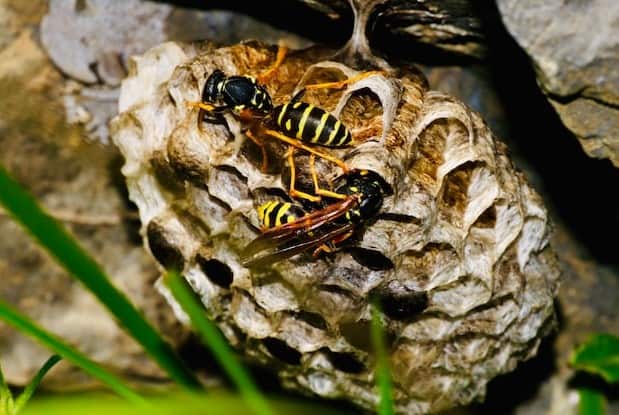
In a previous post, we outlined the signs of bees and wasps in your home.
In this blog post, we’ll outline the key differences between a bee nest and a wasp nest. We’ll cover what you need to know to keep yourself safe in the presence of either.
Wasp Nest vs. Bee Nest – Location
Bees: Commonly in Cavities
Bee nests are commonly called bee hives. Bees are primarily cavity dwellers, though some bee species will build their bee hives in the open.
As seen in the video below, people scale down rock cliffs in Nepal, cutting honeycombs bigger than a man’s torso.
That bee, the Himalayan Giant Honey Bee (Apis laboriosa), constructs honeycombs on the walls of a cliff or under tree branches.
The common honey bee, Apis mellifera, prefers hollow trees and cavities in your walls, roofs, floors, and beehives.
Wasps: More in the Open
Paper wasps will construct their own nests in the open, often in empty light fixtures or on the eaves of roofs.
Yellow jackets are known to build nests in the ground, commonly in abandoned rodent burrows. However, the bald-faced hornet, a species of yellow jacket, builds its nest site above the ground, in a tree branch, on plant stems, or on pre-existing cavities under the eaves of your roof.
Hornets, like bees, prefer to take over cavities such as hollow tree trunks, walls, and even in an undisturbed area of your cabinets.
Wasp Nest vs. Bee Nest – Construction
Bees: Using Wax and Propolis
Bees construct honeycombs using wax, which they excrete from their bodies. It requires a lot of energy to produce wax, so they primarily build comb in the spring.
During this time, there’s enough nectar in nature to fuel their little wax-producing bodies.
To protect themselves from predators and pathogens, they will use propolis to reduce the entrance size. They would also line the inside of the cavity with propolis as a disinfectant.

Wasps: Using Wood Pulp
Wasp construction varies depending on the species. What you commonly see as aerial nests hanging on trees or under the eave of your roof is usually wood pulp.
Social wasps chew wood off trees and posts with their mandibles and mix it with saliva to make a pulp. They will then use the pulp to construct their cells and protective paper layer.
If you look at the external layer closely, you will notice the different hues of the paper wall. That’s because the wasps will use wood from various sources to form beautiful waves all around the nest.
Both honeybees and wasps build hexagonal chambers for brood and, in the case of bees, for honey storage.
We used to think that bees instinctively knew how to make those perfect hexagons, but now we know that the bees make round cylinders while the wax is still soft and malleable. Only when the wax hardens does it create that hexagonal shape, like a bunch of bubbles.
So, wasps are superior craft bugs because the material they are dealing with isn’t as soft and malleable as wax.
However, the same principle may apply because the pulp is wet when shaped to form cells. Or maybe they are just better at math than their cousins.
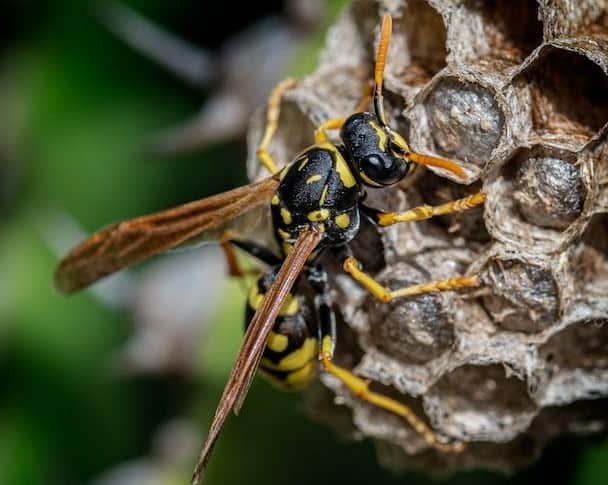
Wasp Nest vs. Bee Nest – Size
Bees: Hives Size Varies
A honey bee colony can occupy a nest for years, so the size of the nest varies. Unlike many other species of native bees, the colony lives all year round and doesn’t hibernate.
Bumble bees, for instance, will start a new nest each spring because the old queen died once the new generation of queens and drones emerged. However, a queen honey bee can live for years.
So, unless the honey bees encounter a problem, they are unlikely to leave an established nest. The colony grows in population and can fill up whatever cavity it occupies with honeycomb to match their needs.
Unlike wasps, honey bee colonies will happily move into an abandoned hive if they come across one. In there, they can build a new honeycomb in addition to the existing comb.
As a result, a honeybee colony can fill a crawl space if it sits undisturbed for years.
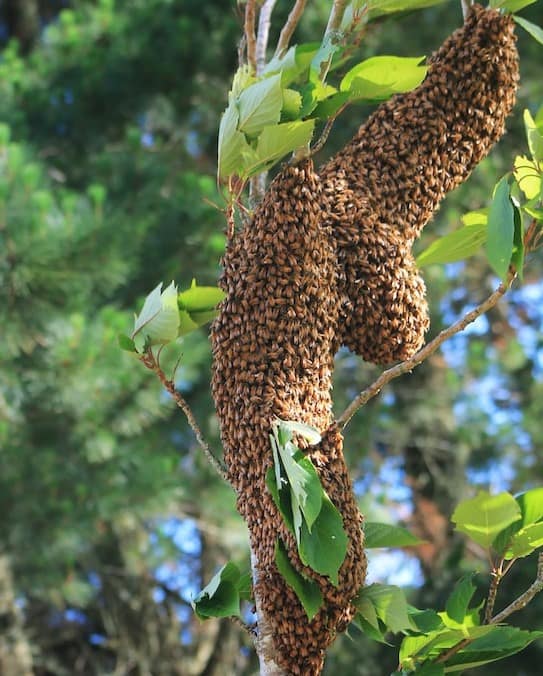
Wasps: Nests are Generally Smaller
Paper wasps construct open comb, and the colonies remain relatively small, a few dozen at their peak. The nest will look like an upside-down umbrella, with a stalk connecting it to the surface of the construction.
In the case of ground-nesting yellow jackets, the nest entrance can be hidden, which is why most stinging incidences occur without advance notice.
If you dig up a yellow jacket wasp nest, it is about the size of a fully inflated basketball, sometimes slightly bigger. These ground nests are home to a few thousand adult wasps during their peak season, so they can be problematic if they feel threatened.
Hornets can number in the thousands in large colonies during the summer. A hornet nests in cavities such as hollow stems or trees or even in man-made structures such as walls and other wooden structures. They also make their nests in trees with paper walls protecting the interior.
Wasps only need their nest from spring to fall. They don’t recycle wasp nests. As a result, their colony size is smaller, and their nests are often smaller than that of an established bee colony.
However, there are always exceptions to the rule. But on average, a wasp nest would be the size of a well-inflated basketball.
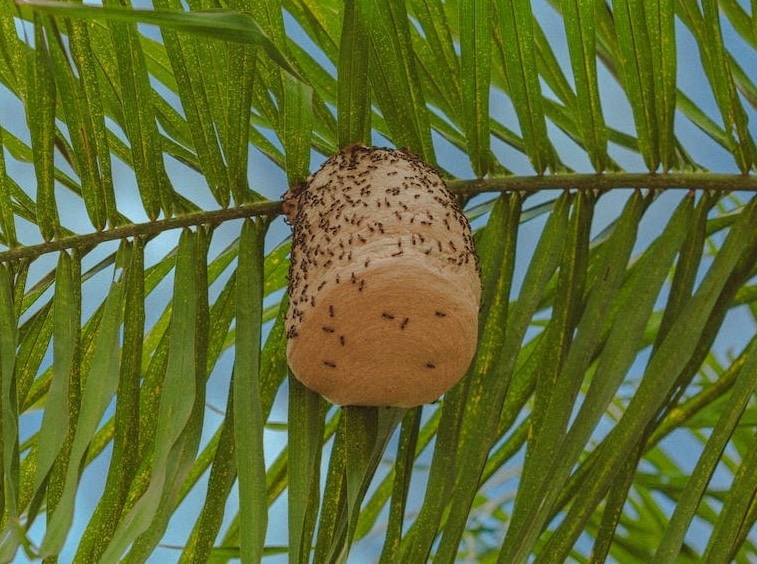
Wasp Nest vs. Bee Nest – Design
Bees: Top-down Construction
Honey bees build their comb from the top down. That’s why Langstroth beehive frames hang down, encouraging the bees to build straight honeycombs that we can manipulate.
The bees attach the comb to the bottom part of the frame and then construct cells downward, in an upside-down pyramidal shape, until they’ve covered the length of the frame.
In a tree, the bees will attach the honeycomb to the highest point of the cavity and side to strengthen the honeycomb.
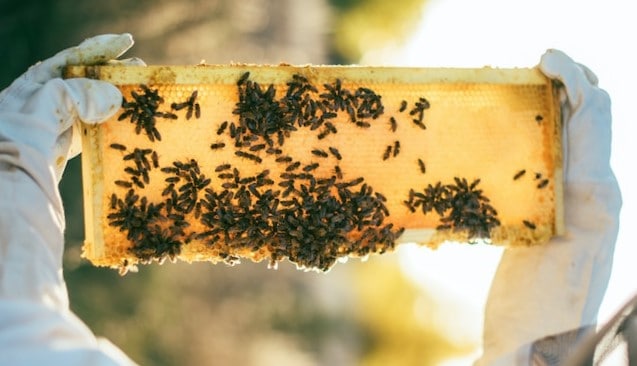
Wasps: Horizontal Construction
Wasps construct their comb to look like a stack of pancakes. They build their comb horizontally connected using little support structures, like pillars in a building.
If you peel away the outer paper layers of an abandoned wasp nest, you will see that the combs lie stacked one on top of the other, with enough space in between for the adult wasps to move in and out to care for the larvae.
It is similar to the principle of bee space in a hive. The space bees leave between comb allows for movement and ventilation.
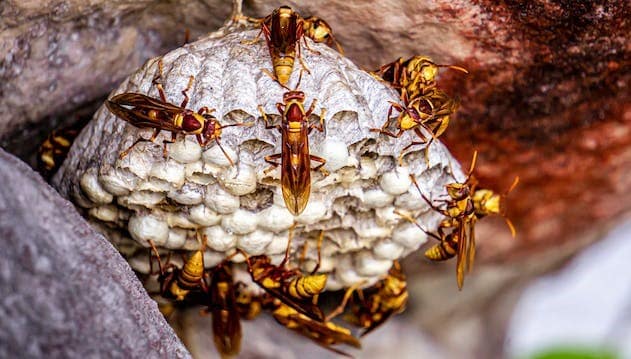
What to do When You Find Either a Wasp Nest or a Bee Nest
Now that we have an idea of the major differences between bee nests and wasp nests, we can easily identify what to do next once we see them.
If you find a feral bee colony that has colonized a space where they can cause a stinging risk, call your nearest beekeeper before you call an exterminator.
Experienced beekeepers safely relocate bee colonies because it can save them the cost of buying package bees. If a few bees get left behind, they pose little threat.
Once the beekeeper removes the honeycomb, the few foragers that may come back to the site have little to defend. They may bundle together for the evening but won’t stay there long.
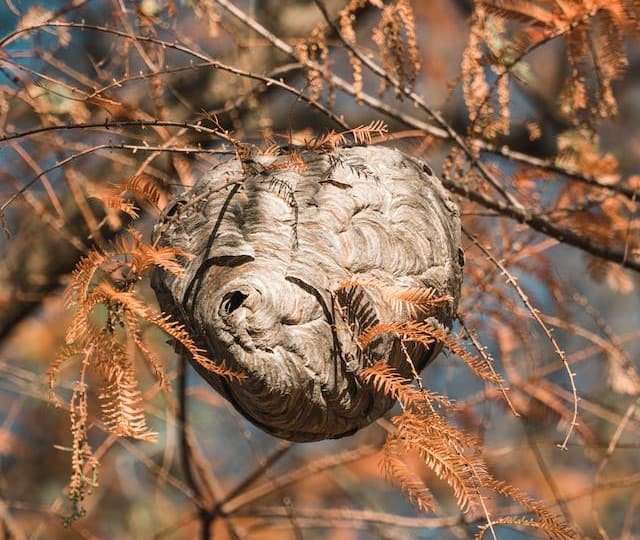
If you come across a wasp nest in the open, don’t go poking around to see if they are home. To be safe, call an exterminator.
Wasps can be aggressive. Like aggressive bees, they can perceive you as a threat because you got too close to their nest.
Though you may not see a wasp nest in a cavity, you will notice a little traffic near the nest entrance. When you do, avoid passing near it until the wasp nests are removed.
Unlike bees that die once they sting you, one wasp can sting you multiple times, so exercise caution.
If you spot a wasp nest that actually does not interfere with you or your loved ones, leave it be. Most often, they die on their own or transfer residency to better places.
Wasps are a vital part of pest management and make it possible to grow vegetables in your backyard organically.
If you have a bee hive nearby, put in an entrance reducer. Hornets destroy bee colonies because they overwhelm the guard bees in front of their beehive.
However, if they can only enter one at a time, the bees can kill the first offender before she has time to go back to her nest to get reinforcements.
Have you encountered wasps near you? Let us know in the comment section below.


We have a massive wasp nest in our shed it’s terrifying.